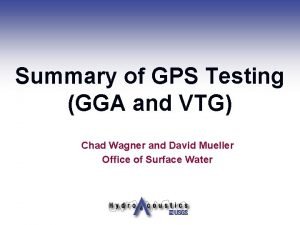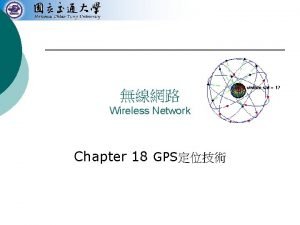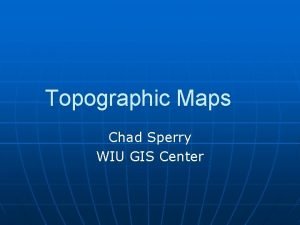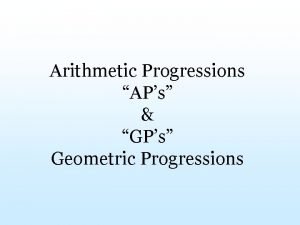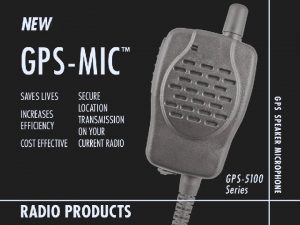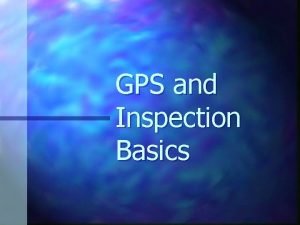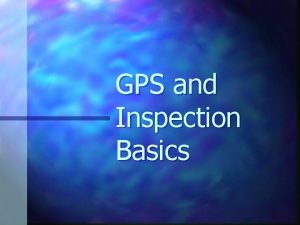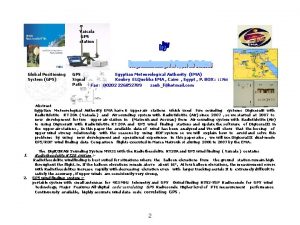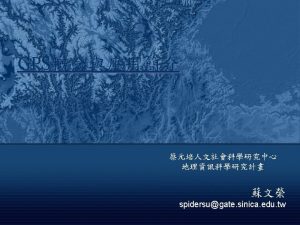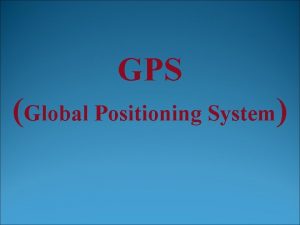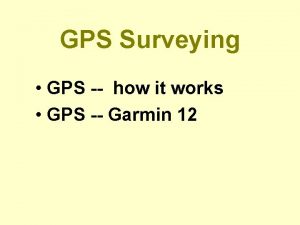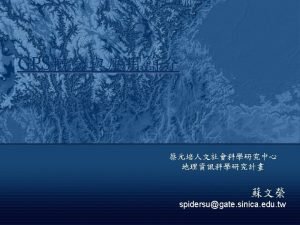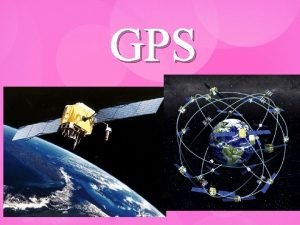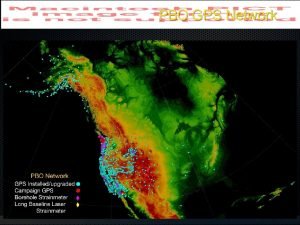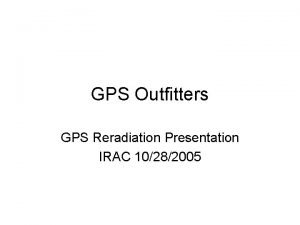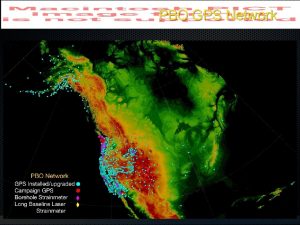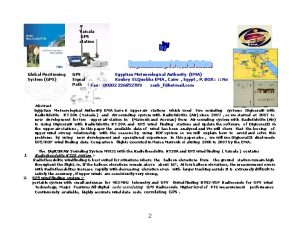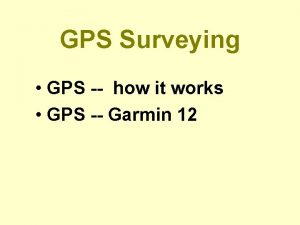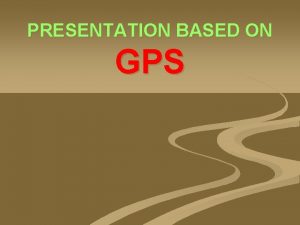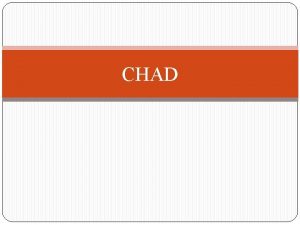Summary of GPS Testing GGA and VTG Chad












































- Slides: 44

Summary of GPS Testing (GGA and VTG) Chad Wagner and David Mueller Office of Surface Water

Overview n n n Background – why do we need GPS? Scope of GPS analysis Integration of GPS and ADCPs n n Description of data Data analysis methods Results n n n GGA vs VTG Discharge comparisons Evaluation of differential correction sources Summary

Background ADCP Measured Velocity The faster the boat travels, the faster the velocity of the water relative to the ADCP.

Background Bottom Tracking n n n Boat velocity or bottom-tracking measurements are similar to the water-velocity measurements Bottom-tracking pulses are sent separate from the water measurement pulses Bottom tracking also measures water depths for discharge computations

Background Example of a Moving Bed

Background Cause of a Moving Bed Transport of material (sediment or other organic material) along the streambed usually by rolling or saltation.

Background What Causes the Moving Bed Bias Environment Canada

Background Why do we need GPS? n Discharges measured using vessel-mounted ADCPs may be biased by bedload transport; this bias is referred to as a moving-bed error. n The moving bed bias introduces an apparent upstream boat velocity, which reduces the calculated downstream water velocity and the corresponding discharge will be biased low. n The integration of a GPS to measure the velocity of the ADCP has been shown to alleviate the systematic errors associated with a moving bed.

Overview n n n Background – why do we need GPS? Scope of GPS analysis Integration of GPS and ADCPs n n Description of data Data analysis methods Results n n n GGA vs VTG Discharge comparisons Evaluation of differential correction sources Summary

Scope of Analysis n The purpose of the analysis is to quantify the bias and random noise associated with GPS-based ADCP discharge measurements relative to bottom-track based discharge measurements; n Sites that did not have a moving-bed condition at the time of measurement were used in the analysis. n The GPS equipment utilized in the analysis was limited to GPS receivers with the capability of providing sub-meter positional accuracy, and does not include Real-time Kinematic (RTK) GPS units. n The analysis is based on 63 bottom-track and GPS-referenced discharge measurements comprised of 579 individual discharge measurement transects collected at 42 different sites across the US, Canada and New Zealand between 2002 and 2007.

Overview n n n Background – why do we need GPS? Scope of GPS analysis Integration of GPS and ADCPs n n Description of data Data analysis methods Results n n n GGA vs VTG Discharge comparisons Evaluation of differential correction sources Summary

Computation of Discharge n To compute the discharge, only the angle between the water-velocity and the boat velocity vectors is needed. True North where Q is the total discharge; T is the total time for which data were collected; D is the total depth; Vf is the mean water-velocity vector; Vb is the mean boat-velocity vector; θ is the angle between the water-velocity vector and the boat-tracking vector; dz is the vertical differential depth; and dt is differential time. Magnetic North Orientation of Instrument Bottom-Tracking Vector Water-Velocity Vector Water-Tracking Vector

Why is the compass important? True North Magnetic North Orientation of Instrument Boat Vector From DGPS Boat Vector from bottom track ADCP Vector Bottom Tracking ADCP Vector DGPS

Two Compass Concerns True North Magnetic North Orientation of Instrument Magnetic variation Boat Vector From DGPS Actual compass reading ADCP Vector DGPS

Integration of GPS and ADCP n Differences between bottom track and GPS referenced discharges can be attributed to either the quality of the GPS data or the accuracy of the ADCP heading measurement as referenced to true north (compass calibration and magnetic variation). n The impact of compass errors on the GPS accuracy was not specifically evaluated in this analysis.

GGA n n Provides position information but no velocity information Velocity is computed in Win. River or River. Surveyor from two consecutive GGA sentences by computing the distance traveled and dividing by the time between the sentences Requires differential correction for acceptable accuracy Affected by multipath errors

GGA Sentence Latitude DDMM. MMMMMM Latitude Direction Sentence ID UTC Time HHMMSS. SS GPS Quality Indicator 0 – invalid fix 1 – nondifferential fix 2 – differential fix See receiver manual for other codes Age of differential correction Geoidal Separation Check Sum MSL Referenc e Longitude HDOP Direction Longitude DDMM. MMMMMM Number of Satellites Meters Base Station ID

VTG n n n Provides velocity only, not position Based on Doppler-shift from the satellite signals to the receiver (typically) Not affected by multipath errors Does not require differential correction Beware of how the receiver handles low velocities Beware of how the receiver handles loss of satellite coverage

VTG Sentence Course (degrees) Speed Check Sum $GPVTG, 62. 2, T, , , 000. 99, N, 001. 83, K, D*79 Course Sentence ID Reference True North Speed Reference kilometers/ho knots ur

Summary of VTG and GGA NMEA Sentences n GGA - Geographic position information determined by reference to the Global Positioning System. The position data includes the time, latitude, longitude, and information about the satellite constellation used to reach the position solution. n VTG - Velocity relative to the ground by measurement of the Doppler shift in the satellite carrier phase frequencies, which includes data on direction and speed. n Not all GPS receivers have the capability to provide the VTG string.

Comparison of VTG and GGA GPS Characteristic VTG GGA Requires at least 4 satellites x x Data quality influenced by PDOP x x Significantly impacted by multipath and satellite changes x Impacted by signal delay bouncing off objects or atmospheric distortion x Requires differential correction for use w/ ADCP x Always record both VTG and GGA data strings, with ALL FILTERS OFF!

Overview n n n Background – why do we need GPS? Scope of GPS analysis Integration of GPS and ADCPs n n Description of data Data analysis methods Results n n n GGA vs VTG Discharge comparisons Evaluation of differential correction sources Summary

Data n Discharges were measured using both bottom-track and GPSreferenced boat velocities for 63 measurements collected at 42 different sites by a variety of agencies, users and instruments. n Each of the 579 measured transects was processed individually and inspected for data quality issues. n The information provided in the discharge summary from Win. River II software (version 2. 03), general comments related to each transect, the GPS positional precision, type of GPS and differential correction source used, update rate for ADCP and GPS data, and the level and location of multipath or boat speed spikes were documented during data processing. n Transects with erroneous data resulting from GPS communication and reception issues were eliminated from the analysis.

Data n The final dataset used for the analysis consisted of: n n n 59 measurements (39 have GGA data, 49 have VTG data, and 30 measurements have both GGA and VTG data); and 535 transects (451 transects have GGA data, 421 transects have VTG data, and 337 transects have both VTG and GGA data); from 39 different sites Stream widths ranged from 50 to 2, 490 ft and average depths ranged from 4. 9 to 26 ft. Average velocities varied from less than 0. 3 ft/s to 6. 5 ft/s. Total discharges varied from 71 ft 3/s to 240, 100 ft 3/s.

Overview n n n Background – why do we need GPS? Scope of GPS analysis Integration of GPS and ADCPs n n Description of data Data analysis methods Results n n n GGA vs VTG Discharge comparisons Evaluation of differential correction sources Summary

Data Analysis Methods n All data were compiled and inspected visually as well as statistically n Problems were easier to identify in GGA data because of the large spikes in boat velocity, but VTG errors were more subtle. n The percent differences (errors) between the GGA and bottom track (BT) referenced discharges, and the VTG and BT referenced discharges were calculated for each individual transect and the mean discharge of all transects at each of the measurement sites.

Data Analysis Methods n A Wilcoxon Signed-Rank hypothesis test was used to determine if the mean percent differences (errors) between GGA and BT referenced discharges and VTG and BT referenced discharges are statistically different from zero (biased).

Overview n n n Background – why do we need GPS? Scope of GPS analysis Integration of GPS and ADCPs n n Description of data Data analysis methods Results n n n GGA vs VTG Discharge comparisons Evaluation of differential correction sources Summary

Results – Discharge Comparisons n Data comparisons between GPS and Bottom trackbased discharges were based only on the data where both GGA and VTG data were collected. n This approach eliminates any difference in site conditions that could affect the results of the analysis. n Discharges were compared using all individual transects and mean discharge at each measurement site.

Results – Discharge Comparisons Using Individual Transects Comparison of the discharges computed using bottom track and GGA as the boat velocity reference

Results – Discharge Comparisons Using Individual Transects Comparison of the discharges computed using bottom track and VTG as the boat velocity reference

Results – Discharge Comparisons Using Individual Transects n Graphically it would appear that there is little difference between the BT and GGA or VTG based discharges. n The Wilcoxon Signed-Rank test indicates that: n n The mean difference between GGA and BT-based discharges was not biased at the 95% significance level (p=0. 072) ; The mean difference between VTG and BT-based discharges is biased at the 95% significance level (p=0. 015).

Results – Discharge Comparisons Using Individual Transects n Even though the Signed-Rank test indicates the VTG data is biased, the mean differences for both data sources are small (0. 39% for VTG and -0. 52% for GGA).

Results – Discharge Comparisons Using Individual Transects Variation in percent difference for transects based on mean water velocities and stream width

Results – Discharge Comparisons Using Individual Transects n Filtering the data to evaluate only the data with velocities greater than 0. 20 m/s(0. 65 ft/s) results in a dataset with a minimum mean velocity of 1. 1 ft/s and a minimum width of 48 ft. n For this condition, the hypothesis test again shows that the mean percent difference for the GGA data is not significantly different from zero (p=0. 122) but the VTG data are biased (p=0. 032) at the 95% significance level.

Results – Discharge Comparisons Using Individual Transects n If, however, the data are filtered to evaluate only data with stream widths > 25 m (82 ft), the resulting data have a minimum mean velocity of 0. 07 m/s (. 23 ft/s) but a minimum width of 56 m (183 ft). n The hypothesis test on these data shows that the mean percent difference from BT for both the GGA (p=0. 337) and the VTG (p=0. 129) data are not significantly different from zero at the 95% significance level.

Results – Discharge Comparisons Using Individual Transects n On the basis of these data and the hypothesis tests: n The discharges measured using GGA as the boat velocity reference can be considered to have no bias relative to discharges measured using bottom track as the boat velocity reference. n The hypothesis test on the VTG data indicate that there is no bias in discharge for streams greater than 56 m (183 ft) wide, but a bias of 2. 65% for streams with widths < 25 m (82 ft).

Results – Discharge Comparisons Using Mean Discharge Measurements n The discharge comparisons based on individual transects more heavily weights the effects of conditions at sites where a larger number of transects were collected. n To eliminate this potential problem the mean discharge at each measurement site was computed using each reference, which resulted in 30 measurements for each boat reference

Results – Discharge Comparisons Using Mean Discharge Measurements n The hypothesis tests on mean discharge measurements indicate that the mean percent difference from bottom tracking for both the GGA (p=0. 175) and the VTG (p=0. 416) data are not significantly different from zero at the 95% significance level.

Results – Evaluation of Differential Correction Sources n Measured discharges were evaluated using differentially corrected GGA as the navigation reference for three wide-area satellite-based differential correction sources commonly used in North America: 1. WAAS 2. Omni. STAR 3. CDGPS

Results – Evaluation of Differential Correction Sources

Summary n The data and analysis indicate that discharge referenced to GGA or VTG data are, on average, within about +/- 0. 5% of that measured using bottom tracking. n There were considerably more random errors and outliers in the percent differences between GPS and bottom track referenced discharges for sites with mean velocities less than 0. 20 m/s (0. 65 ft/s) and/or stream widths less than 25 m (82 ft).

Summary n WAAS appears to be an adequate differential correction source for ADCP discharge measurements, if errors less than 2 % are acceptable. n The data also indicate that VTG provides similar discharges to those based on GGA data and could be a valuable alternative where differential corrections may be difficult or impossible to obtain.

Questions?
 Gga chad
Gga chad Gps gps gps
Gps gps gps Gps gps gps
Gps gps gps Positive testing vs negative testing
Positive testing vs negative testing Static testing and dynamic testing
Static testing and dynamic testing Chad b swim helping verbs
Chad b swim helping verbs Ilan raymond
Ilan raymond Chad ulven
Chad ulven Wiu gis
Wiu gis Chad vs sigma
Chad vs sigma Chad topaz
Chad topaz Chad ostlund
Chad ostlund Chad posner
Chad posner Uiaddi
Uiaddi Chad lessard
Chad lessard Chad blight
Chad blight Mainframe ransomware
Mainframe ransomware Chad braley
Chad braley Gordon saxe
Gordon saxe Chad gifford columbia
Chad gifford columbia Chad gestson salary
Chad gestson salary Chad meyerhoefer
Chad meyerhoefer Control measures of soil erosion slideshare
Control measures of soil erosion slideshare Chad kessens
Chad kessens Chad imperialism
Chad imperialism Chad eggerman
Chad eggerman What is domain testing
What is domain testing Motivational overview of logic based testing
Motivational overview of logic based testing Data flow testing strategies in software testing
Data flow testing strategies in software testing What is globalization testing
What is globalization testing Neighborhood integration testing
Neighborhood integration testing Language testing
Language testing Control structure testing in software engineering
Control structure testing in software engineering Decision table testing in software testing
Decision table testing in software testing Decision table advantages and disadvantages
Decision table advantages and disadvantages Pengertian black box testing
Pengertian black box testing Behavioral testing adalah
Behavioral testing adalah Table based testing
Table based testing Rigorous testing in software testing
Rigorous testing in software testing Testing blindness in software testing
Testing blindness in software testing Component testing is a black box testing
Component testing is a black box testing Software domain examples
Software domain examples Employee testing and selection summary
Employee testing and selection summary Aps and gps
Aps and gps Testing oral ability
Testing oral ability
